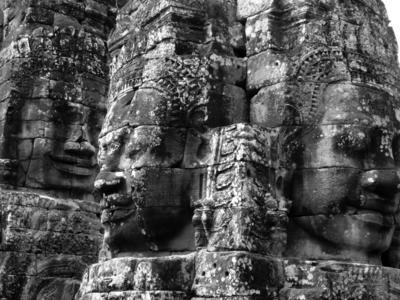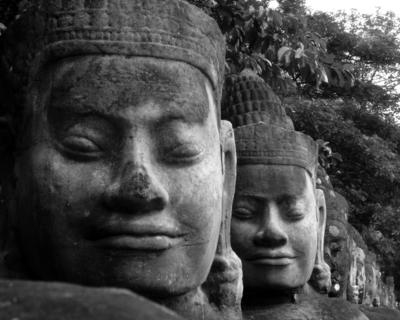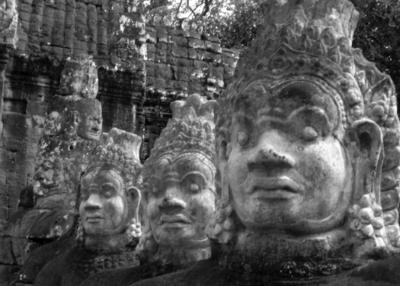
Wednesday, August 9, 2006
Tuesday, October 18, 2005
Ta Prom: The Jungle Temple
 The temple of Ta Prom has been left more or less as it was found, with an overgrowth of jungle and portions tumbled down. It gives you some idea of what the first westerners found when they began exploring the area in the late 19th century.
The temple of Ta Prom has been left more or less as it was found, with an overgrowth of jungle and portions tumbled down. It gives you some idea of what the first westerners found when they began exploring the area in the late 19th century.When I told people I was going to Cambodia, they often asked "Cambodia? Why? What's there?" Once I said Angkor Wat, a light went off in many of their heads. "Oh! That's where they made Tomb Raider! Sweet!" Well, I haven't seen Tomb Raider (Angelina Jolie), and I probably never will. If you have, this may look a bit familliar.
Massive webs of Banyon roots cling to sandstone walls, stained by centuries and dancing with intricately carved apsaras. Mounds of moss-rocks, victims of neglect and the the crushing roots of the encroaching jungle, lie defeated, scattered throughout the temple grounds. Droplets of light trickling through the lush green foilage, caught in the mist of monsoon season, creates a mysterious, ethereal air.
Though many signs warn tourists of the danger of exploring most of the tumbling temple grounds, I couldnt help but scatter up mountains of fallen stones into hidden courtyards,stumbling over the tangle of knarled roots slithering down the walls and through the temple passages, and past the warning signs standing gaurd in the darkened doorways of the temple's shadow-veiled interior. I even stumbled into a small chamber acoustically designed so that when I beat upon my chest, the entire temple seemed to shutter from the thunderous echo. I was in full Indaina Jones mode. I could have stayed there forever.
Apparently this is the doorway where Angelina Jolie bends down and picks something up. Anyone who's seen the movie, please feel free to elaborate!
I was lucky to visit the temple at a time when most tourists are headed elsewhere! These few stand in awe.
Sunday, October 2, 2005
The Faces of Bayon
When Zhou Daguan visited Angkor in 1297-98, Bayon's towers were covered in gold. While Angkor Wat was kept from the ravages of the jungle by devoted Buddhist monks, Bayon was forgotten, left to the mercy of nature.
From a distance, it seemed the jungle had taken its revenge on the eerie mass of jumbled rocks known as Bayon. I approached it in awe as hundreds of faces began to emerge from the tangled mass of stone and shadow. 54 towers chaotically assaulted the sky, each in its own plain, creating an intimidating sense of height.
When Chinese ambassador Zhou Daguan visited Angkor before the dawn of the 14th century, the city was dripping with the gold and riches of empire.
"At the center of the Kingdom rises a Golden Tower flanked by more than twenty lesser towers and several hundred stone chambers," Zhou wrote.
"On the eastern side is a golden bridge guarded by two lions of gold, one on each side, with eight golden Buddhas spaced along the stone chambers."
The"golden" period of the Khmer Empire was not a peaceful one. Rival powers from present-day Vietnam, Thailand, and Burma struggled with the Khmers for regional domination. Ironically, the Khmers' architectural prowess aided in their demise, as extensive temple construction, combined with frequent military conflicts, eventually drained the empire's resources. As the empire declined, Angkor was sacked several times, the gold and jewels stripped as spoil by invading armies. Bayon was one of the last great achievements of the empire, but fell in 1432 to the Thais, and was soon after forgotten.
The gold and jewels may be gone, but the mystique and grandeur of the Khmer kingdom endures.

A translation of King Jayavarman VII`s mystic Buddhist beliefs, Bayon is a spiritual experience. From each of the survivng towers the enlightened grin of the Boddhisattva Avalokitesvara, one of the most worshipped divinities in Mahayana Buddhism and the kingdom's principal divinity, compassion radiates out in the four cardinal directions. Carved in the likeness of the King himself (his portrait is known from other sculptures found elsewhere in Cambodia and Thailand), these enigmatically smiling faces portray the King as god, symbolizing his omnipresence and omnipotence.
The Khmer Smile.
Bodhisattva Avalokitesvara is believed to be the embodiment of compassion. A bodhisattva is motivated by compassion to seek enlightenment for all beings. The 216 faces haunting the heights of Bayon project benevolence outward in all directions, and are believed to bring hope, happiness, peace, and protection to all, especially those living in the Khmer Empire.
As I wandered around in wonder, watched by the eyes of Big Brother, Bayon-style, I couldn't help but feel like I was trapped in an MC Escher drawing. I don't think I could ever have believed such a place existed, even in my dreams, and I certainly never imagined that someday I would see it with my own two eyes.
Saturday, October 1, 2005
The Road To Angkor Thom
 The Enlightened eyes of the 54 devas, or lesser gods, gaurding the gate of Angkor Thom.
The Enlightened eyes of the 54 devas, or lesser gods, gaurding the gate of Angkor Thom.Walking along the narrow road to Angkor Thom, dodging motor bikes and bicycles, a long line of elephants appeared in the shade of the jungle, camouflaged in the shadows of leaves. I watched them as I walked along, until when I finally turned my head I saw a massive stone gate rising up like a mountain, from the peak of which I found a face staring back at me, and two more surveying the jungle in each direction. I came to the foot of a bridge over a large moat, once filled with alligators to detour trespassers like myself. I crossed the causeway, encouraged by the serene smiles of 54 devas on my left, though from my right I felt the heavy stare of 54 demons. Peering down from above, the omniscient eyes of the gatekeeper seemed to watch my every step. I felt as if I were passing through the oracle in the Never Ending Story.
 The watchful eyes of Angkor Thom's demons.
The watchful eyes of Angkor Thom's demons.Niether the gate of Angkor Thom, nor the eyes of its gaurdians, can prepare you for the jewel of the jungle: Bayon.
Friday, September 30, 2005
Home of the Gods
Thursday, September 29, 2005
On Earth As It Is In Heaven
The legendary origins of Angkor Wat (or Capital Temple), according to locals, lie in the story of Preah Ket Melea, son of the king of heaven and a mortal woman. The gods complained that he smelled, and asked his father to send him down to Earth. The king agreed, offering his son the opportunity to have an exact replica of any edifice in heaven erected on Earth with the help of the celestial architect (whom villagers still invoke whenever a building is constructed). A modest man, Preah Ket Melea chose the stable. An ox was released onto the plain of Angkor and the place where it layed down became Heaven on Earth: Angkor Wat.





